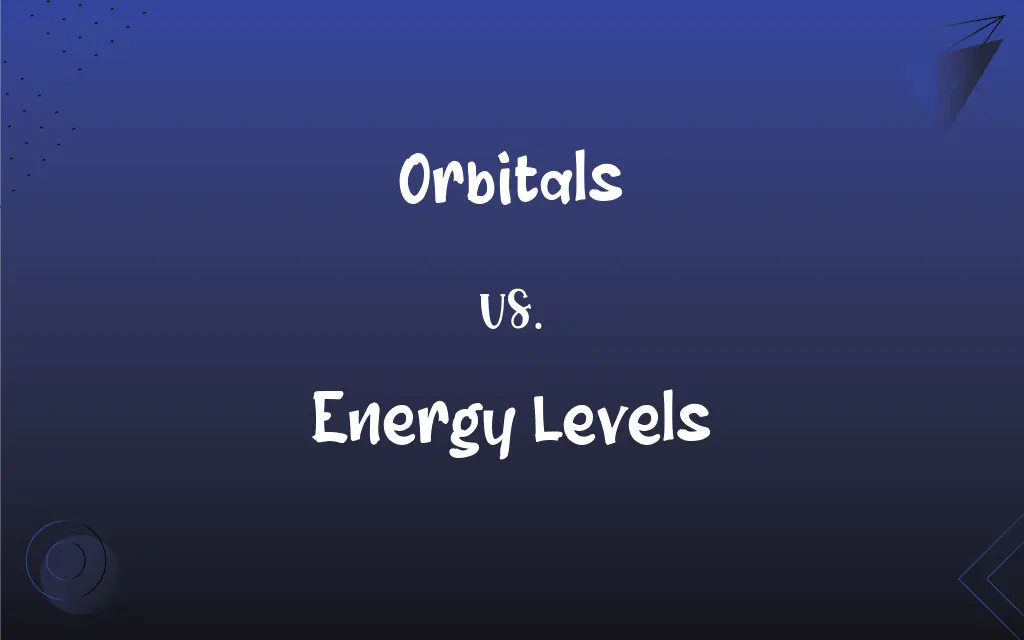Orbitals vs. Energy Levels: What's the Difference?
Edited by Aimie Carlson || By Janet White || Published on August 20, 2024
Orbitals are specific regions around an atom's nucleus where electrons are likely to be found, while energy levels are the discrete energies that electrons can have in an atom.

Key Differences
Energy levels in an atom represent the discrete amounts of energy that electrons can possess. These levels are quantized, meaning electrons can only occupy certain energy states, with specific energy values. The concept of energy levels helps explain the structure of the atom and the distribution of electrons in different shells around the nucleus. Orbitals, on the other hand, are more specific than energy levels. They describe the spatial distribution of electrons within these energy levels, providing a probabilistic map of where an electron is likely to be found at any given time.
Each energy level can contain one or more orbitals, with each orbital having a maximum capacity of two electrons. The energy levels are often referred to by their principal quantum number (n=1, 2, 3, etc.), and they increase in energy as the distance from the nucleus increases. Within these energy levels, orbitals are defined by three quantum numbers: the principal quantum number (n), the azimuthal (angular momentum) quantum number (l), and the magnetic quantum number (m). These quantum numbers describe the shape, orientation, and energy of the orbitals within a given energy level.
Orbitals are categorized into different shapes and types, such as s, p, d, and f, which indicate the shape of the region in space where an electron is likely to be found. The s orbital is spherical, while p orbitals are dumbbell-shaped, and d and f orbitals have more complex shapes. Energy levels, in contrast, are more about the electron's potential energy due to its position relative to the nucleus and do not directly specify the electron's spatial distribution.
The relationship between orbitals and energy levels is fundamental to understanding atomic and molecular structure. Energy levels provide a framework for the arrangement of electrons in an atom, while orbitals give detailed insights into the behavior of electrons within those levels. For instance, electrons fill the lowest available energy levels first (a principle known as the Aufbau principle) and distribute among the orbitals in a way that minimizes electron repulsion, following Hund's rule.
Energy levels and orbitals are closely related concepts in quantum chemistry, they serve different purposes. Energy levels denote the discrete energies an electron can have, broadly organizing the electron's position relative to the nucleus. Orbitals offer a more detailed picture, describing the spatial distribution of electrons within these levels, based on the quantum mechanical probabilities.
ADVERTISEMENT
Comparison Chart
Definition
Regions where electrons are likely to be found.
Discrete energy states electrons can occupy.
Capacity
Can hold up to two electrons each.
Can contain multiple orbitals, with varying electron capacities.
Quantum Numbers
Defined by n, l, and m quantum numbers.
Characterized mainly by the principal quantum number (n).
Shape
Have specific shapes (s, p, d, f).
Do not have shapes, but represent energy ranges.
Role
Describe the electron's spatial distribution within an energy level.
Define the energy hierarchy in an atom.
ADVERTISEMENT
Orbitals and Energy Levels Definitions
Orbitals
Quantum states where electrons reside around an atom's nucleus.
The 1s orbital is the closest orbital to the nucleus.
Energy Levels
Integral to understanding atomic spectra.
The emission of light from atoms occurs when electrons drop to lower energy levels.
Orbitals
Characterized by a maximum of two electrons.
Each orbital can be filled with up to two electrons with opposite spins.
Energy Levels
Basis for the electron configuration of elements.
The arrangement of electrons in energy levels follows the Aufbau principle.
Orbitals
Determined by three quantum numbers.
The quantum numbers for orbitals include n, l, and m.
Energy Levels
Organized in shells around the nucleus.
The first energy level can hold up to two electrons in its shell.
Orbitals
Defined by specific shapes and orientations.
P orbitals have a dumbbell shape, extending in three-dimensional space.
Energy Levels
Quantized states of potential energy for electrons in an atom.
Electrons move to higher energy levels when they absorb energy.
Orbitals
Influences chemical bonding and reactivity.
Electron configurations in outer orbitals determine an atom's chemical properties.
Energy Levels
Increase in energy with distance from the nucleus.
Electrons in higher energy levels are further from the nucleus and have more energy.
Orbitals
Of or relating to an orbit.
Orbitals
The wave function of an electron in an atom or molecule, indicating the electron's probable location.
Orbitals
Plural of orbital
FAQs
What distinguishes an orbital from an energy level?
Orbitals describe specific electron distributions within an energy level.
What are the shapes of orbitals?
Orbitals come in shapes like spherical (s), dumbbell (p), and more complex patterns (d, f).
Can energy levels overlap in energy?
In multi-electron atoms, energies of orbitals from different levels can overlap.
What quantum numbers define an orbital?
Orbitals are defined by n, l, and m quantum numbers.
How are energy levels numbered?
Energy levels are numbered by principal quantum numbers starting from 1.
What role do orbitals play in chemical bonding?
Orbitals overlap during bond formation, sharing or transferring electrons.
How does the shape of an orbital affect an atom's chemistry?
The shape determines how atoms interact and bond with each other.
Do all atoms have the same number of orbitals?
The number of orbitals increases with the number of electrons an atom has.
What is the maximum number of electrons in the first energy level?
The first energy level can hold up to 2 electrons.
How many electrons can an orbital hold?
Each orbital can hold a maximum of two electrons.
Why are energy levels quantized?
Quantum mechanics dictates that electrons can only occupy specific energy states.
How are orbitals visualized in quantum chemistry?
Orbitals are often represented by cloud-like shapes indicating electron probability distributions.
Can two electrons in the same orbital have the same spin?
No, due to the Pauli exclusion principle, two electrons in the same orbital must have opposite spins.
How do electrons fill orbitals?
Electrons fill the lowest energy orbitals first according to the Aufbau principle.
Are all orbitals within an energy level the same energy?
Within a single electron atom, yes; in multi-electron atoms, sublevels can have slightly different energies.
How do electrons move between energy levels?
Electrons absorb or release energy to move between levels.
How do orbitals contribute to the atom's overall energy?
Electrons in orbitals contribute to the atom's potential and kinetic energy.
Can an energy level exist without orbitals?
No, energy levels are defined by the orbitals they contain.
Why are p orbitals degenerate in hydrogen?
In hydrogen, all p orbitals in the same energy level have the same energy due to the absence of electron-electron repulsion.
What happens to an electron's energy when it jumps to a higher orbital?
The electron absorbs energy, increasing its potential energy.
About Author
Written by
Janet WhiteJanet White has been an esteemed writer and blogger for Difference Wiki. Holding a Master's degree in Science and Medical Journalism from the prestigious Boston University, she has consistently demonstrated her expertise and passion for her field. When she's not immersed in her work, Janet relishes her time exercising, delving into a good book, and cherishing moments with friends and family.
Edited by
Aimie CarlsonAimie Carlson, holding a master's degree in English literature, is a fervent English language enthusiast. She lends her writing talents to Difference Wiki, a prominent website that specializes in comparisons, offering readers insightful analyses that both captivate and inform.






































































